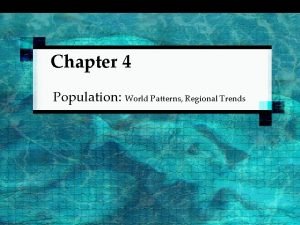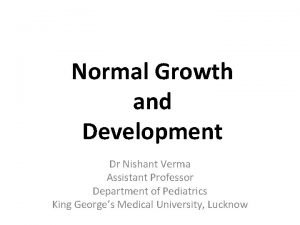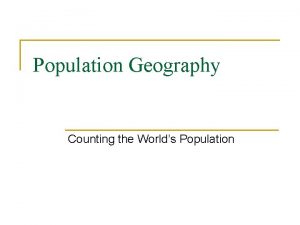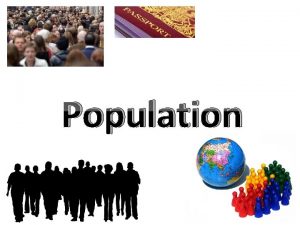Population Where has the worlds population increased Crude














- Slides: 14

Population Where has the world’s population increased?

Crude Birth Rate (CBR) Crude Death Rate (CDR) or Mortality Rate ◦ Total # of births/year for every 1000 people ◦ Ranges 5 -50 (high 30+) ◦ Total # of deaths/year for every 1000 people ◦ Ranges 1 -28 ◦ In 1994, CDRs for LDCs dropped below MDCs & have remained lower ever since Natural Increase Rate (NIR) ◦ % in which a population grows in a year CDR-CBR ◦ Excludes migration ◦ Ranges (-0. 1)-3. 4 Measures of Population Change

World Population Growth 1950– 2000 Fig. 2 -6: Total world population increased from 2. 5 to 6 billion in this half century. The natural increase rate peaked in the early 1960 s and has declined since, but the number of people added each year did not peak until 1990.

World NIR = 1. 3% All-time peak was in 1963 = 2. 2% Small changes in NIR = BIG impacts Doubling time: # of years it takes to a population double ◦ Rule of 70/72 (divide 70/72 by NIR) Almost 100% of NI is in LDCs Africa (Sub-Saharan), Asia, Latin America & Middle East (NIR +2%) Correlation between high NIR rates & low status of women…. . why? ? ? Natural Increase

Country A has a BR of 22/1000 Country A has a DR of 12/1000 NIR = 10/1000 or 1% NIR Example

Natural Increase Rates Fig. 2 -7: The natural increase rate (NIR) is the percentage growth or decline in the population of a country per year (not including net migration). Countries in Africa and Southwest Asia have the highest current rates, while Russia and some European countries have negative rates.

Total Fertility Rate (TFR): ave. # of children a woman will have in her child-bearing yrs (15 -49) Since 1960, ave. TFR in LDCs has fallen from 6. 0 to 2. 9 (largest decline in L. A. & Asia) *more rapid than expected World average = 2. 4 20 years ago = 3. 8 SS Africa = 6+ MDCs = 1. 6 20 years ago = 2. 0 Fertility

Religion & Babies (Ted Talks)

Life Expectancy: # of yrs a newborn can expect to live ◦ Largely influenced by IMRs ◦ Women live longer than men ◦ 70+ in MDCs & as little as late 30 s in SS Africa ◦ mainly due to AIDS; Botswana/Zimbabwe ◦ Japan has the highest LE ◦ Can change quickly ◦ Males in USSR dropped from 68 to 62 following collapse of communism and now in Russia for males it’s 58 Mortality

Infant Mortality Rate (IMR): # of babies under 1 yr that die annually compared to live births Reflect overall health of a society 10% in LDCs, less than 5% in MDCs Higher in USA than in Canada/most of Europe Leading cause of death; diarrhea & malnutrition Lowest rates (under 3/1000) in Japan, Singapore & Sweden Highest rates (125/1000+) in Sierra Leone & Afghanistan (1 in every 8) Large differences within countries (race) Mortality cont’d. .

Life Expectancy at birth Fig. 2 -11: Life expectancy at birth is the average number of years a newborn infant can expect to live. The highest life expectancies are generally in the wealthiest countries, and the lowest in the poorest countries.

Most important geographic region to pop. Growth India (PGR 1. 3)to overtake China in coming years (PGR 0. 4) Sri Lanka (21 million) only country with growth rate lower than world average in this region Pakistan & Bangladesh have a combined pop. of 300 million South Asia

Currently East Asia worlds most populous region is China’s NIR has fallen below 1% Japan’s pop. Beginning to decline Growth between 2000 -2050 ◦ Africa will account for +1/3, outnumbering China by 8 x ◦ India reached 1 billion in 2000, is projected to grow by an additional 50% ◦ Europe’s pop. Is projected to ↓ by 70 million Projected Growth

Highest Rates ◦ ◦ ◦ ◦ ◦ Birth Rwanda Malawi Yemen Uganda Ethiopia Niger Mali Burundi Afghanistan Tanzania Lowest Rates ◦ ◦ ◦ ◦ ◦ Birth Italy (Roman Catholic? !? !) Greece Japan Spain Austria Germany Hungary Denmark Portugal Do you notice any patterns? ? ?
 Slides
Slides Physiological density vs arithmetic density
Physiological density vs arithmetic density Crude population density
Crude population density Study guide chapter 4 section 1 population dynamics
Study guide chapter 4 section 1 population dynamics Chapter 4 population ecology answer key
Chapter 4 population ecology answer key Population ecology section 1 population dynamics answer key
Population ecology section 1 population dynamics answer key Population ecology section 1 population dynamics
Population ecology section 1 population dynamics Deliberate adulteration examples
Deliberate adulteration examples Classification of crude drugs
Classification of crude drugs 2 finger pincer grasp
2 finger pincer grasp Crude oil
Crude oil Evaluation of crude drugs
Evaluation of crude drugs Yellow journalism
Yellow journalism Difference between organised and unorganised crude drug
Difference between organised and unorganised crude drug Calculation of birth rate
Calculation of birth rate



























